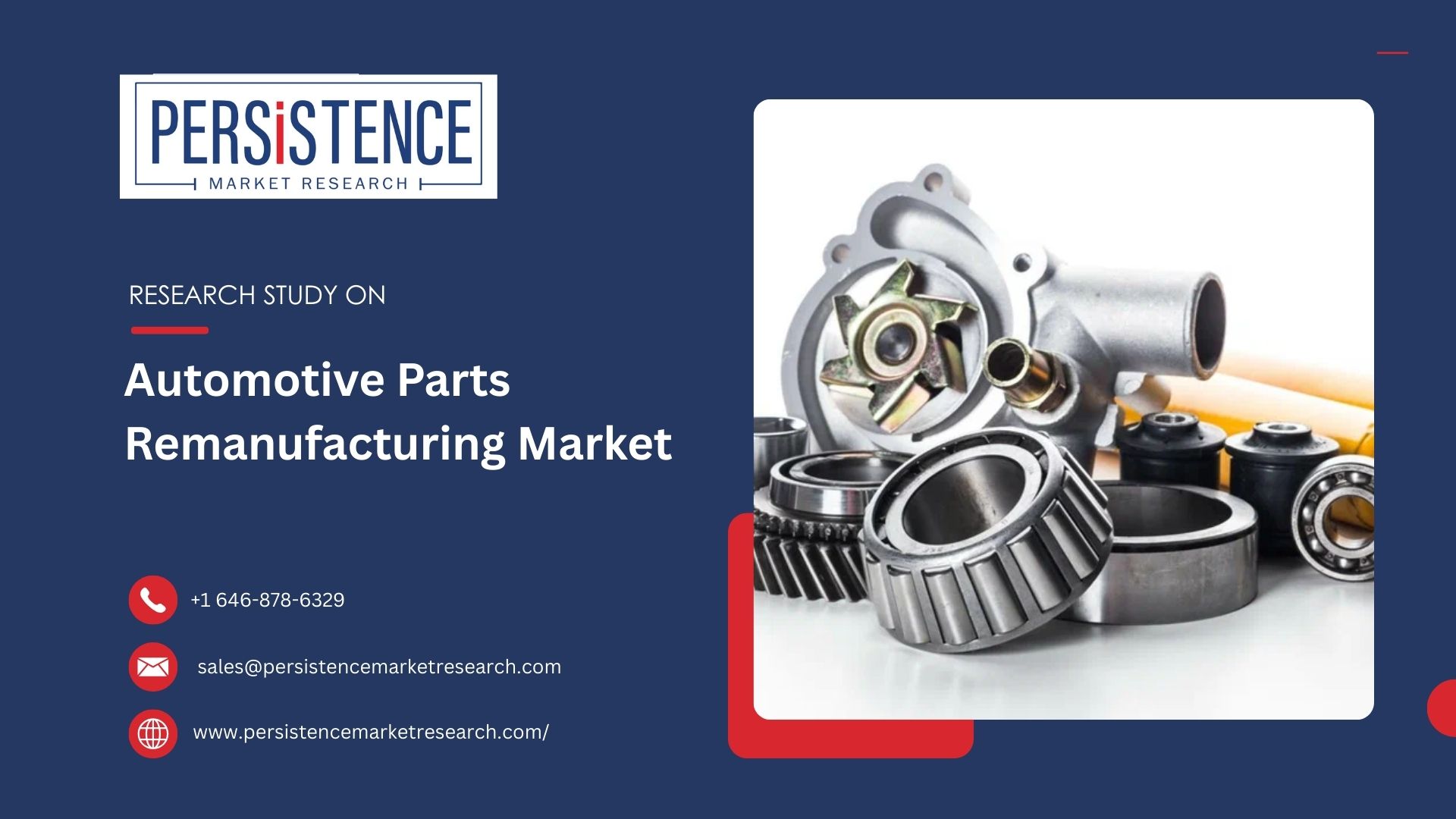Forecasting Growth in North American Automotive Component Remanufacturing

Strong 8k brings an ultra-HD IPTV experience to your living room and your pocket.
The automotive component remanufacturing industry is an essential pillar of the broader automotive sector in North America, providing cost-effective, sustainable, and high-quality solutions for replacing worn or damaged automotive parts. With increasing focus on reducing carbon footprints, improving manufacturing efficiency, and minimizing waste, the North American automotive component remanufacturing market is experiencing rapid growth. As new technologies and sustainability practices are adopted, the sector’s trajectory looks promising.
According to Persistence Market Research’s projections, the automotive parts remanufacturing market is estimated to increase from US$ 70.1 billion in 2024 to US$ 130.6 billion by 2031. The market is projected to record a compound annual growth rate (CAGR) of 9.3% during the forecast period from 2024 to 2031. These figures underscore the remarkable growth expected in North America’s automotive remanufacturing industry, which will be fueled by technological innovations, shifting consumer preferences, and a growing emphasis on sustainability.
In this blog, we will explore the factors driving the growth of North America's automotive component remanufacturing market, the trends shaping the future of the industry, and the potential challenges that lie ahead.
Key Drivers of Growth in North American Automotive Remanufacturing
North America’s automotive component remanufacturing market is set for substantial growth. This growth is largely driven by several key factors that are transforming the industry landscape, including advancements in technology, consumer demand for affordable and sustainable solutions, and supportive governmental policies.
1. Technological Advancements
Technological innovation is one of the primary drivers behind the growth of automotive component remanufacturing in North America. Advanced manufacturing technologies, such as automation, artificial intelligence (AI), 3D printing, and robotics, are revolutionizing the way automotive parts are remanufactured. These innovations allow manufacturers to reduce costs, improve efficiency, and achieve higher levels of precision in the remanufacturing process.
For example, AI and machine learning tools are increasingly being used to inspect and evaluate the condition of used automotive components. These tools can identify parts that are suitable for remanufacturing and ensure that only high-quality components make it through the process. 3D printing technology has also become a game-changer, allowing companies to produce complex and customized parts faster, often at lower costs than traditional manufacturing methods.
Furthermore, automation and robotics are streamlining the disassembly, cleaning, and reassembly processes, making them more efficient and reducing human error. These advancements are helping North American manufacturers meet the growing demand for remanufactured automotive components while maintaining high levels of quality.
2. Consumer Demand for Cost-Effective Alternatives
The high cost of new automotive parts has created a strong demand for remanufactured components in North America. For many consumers, purchasing remanufactured automotive parts provides a significant cost-saving opportunity without sacrificing quality. As vehicles age, their owners need replacement parts, but the cost of brand-new components can often be prohibitive. Remanufactured parts offer a high-quality alternative at a fraction of the price of new ones, making them a popular choice in both the consumer and commercial sectors.
For businesses, using remanufactured parts helps keep maintenance costs down while providing customers with affordable solutions. This demand for cost-effective, high-quality alternatives is expected to increase as more consumers and businesses recognize the value of remanufactured parts.
3. Sustainability and Environmental Benefits
Environmental concerns have increasingly become a major factor driving the growth of the remanufacturing market. Remanufacturing reduces the need for raw materials, cuts down on waste, and decreases energy consumption compared to the production of new parts. For consumers, choosing remanufactured parts aligns with a growing desire to make more sustainable choices and reduce their carbon footprints. North American manufacturers are capitalizing on this trend by emphasizing the environmental benefits of remanufactured components.
Governments across North America are also adopting policies that support sustainability. In the United States, for example, regulations are encouraging companies to embrace circular economy practices, which include remanufacturing. These regulations, along with incentives for environmentally responsible manufacturing, create a favorable environment for the growth of the automotive remanufacturing industry.
4. Aging Vehicle Fleet
North America's vehicle fleet is aging, with the average age of cars and trucks on the road increasing every year. According to recent studies, the average age of vehicles in the U.S. is over 12 years, with millions of vehicles well beyond their original warranty period. As these vehicles age, the demand for replacement parts, including remanufactured components, rises.
Owners of older vehicles often seek remanufactured parts as a more affordable alternative to new parts. This aging fleet is expected to continue driving demand for remanufactured automotive components, helping fuel the market’s growth.
5. Regulatory Support and Incentives
Government policies and incentives play a critical role in fostering growth in the remanufacturing sector. In the United States, various federal and state regulations encourage the adoption of sustainable manufacturing practices, including remanufacturing. These regulations are particularly relevant as manufacturers seek ways to reduce their environmental impact and meet stricter emission standards.
Additionally, some state governments offer tax credits and financial incentives for companies investing in green technologies or sustainable production processes. Such measures are encouraging more companies to enter the remanufacturing space, further driving the growth of North America's automotive remanufacturing market.
Key Trends Shaping the Future of the Automotive Component Remanufacturing Market
As the automotive component remanufacturing market in North America continues to expand, several trends are shaping the future of the industry.
1. Shift Toward Electric Vehicles (EVs)
The global shift toward electric vehicles is likely to have a profound impact on the automotive remanufacturing market. Electric vehicles (EVs) contain many high-tech components, such as batteries and electric drivetrains, which will eventually require remanufacturing. As EV adoption increases in North America, the demand for remanufactured EV components will also grow.
Additionally, EVs are typically more expensive to repair due to the complexity of their systems, which may further drive demand for remanufactured parts that are more affordable. Manufacturers are beginning to explore remanufacturing options for these components, which will play a significant role in the future of the automotive remanufacturing industry.
2. Customization and 3D Printing
Customization is becoming a more prominent trend in the automotive industry, with consumers increasingly seeking personalized solutions. 3D printing has the potential to meet this demand by enabling the creation of customized automotive components. Remanufacturing companies are adopting 3D printing to produce unique parts and offer tailored solutions for customers, further differentiating the remanufactured component market from traditional manufacturing.
3. Improved Supply Chain Integration
As North American manufacturers continue to embrace digital technologies, the integration of supply chains will improve, leading to greater efficiencies in the remanufacturing process. With real-time data tracking, better inventory management, and predictive analytics, companies can streamline their operations and reduce lead times, ensuring they meet the growing demand for remanufactured parts.
Challenges to Overcome
While the automotive remanufacturing market in North America is experiencing robust growth, there are challenges that manufacturers will need to address.
Supply Chain Disruptions
Global supply chain disruptions, such as those caused by the COVID-19 pandemic, have impacted the availability of raw materials and components necessary for remanufacturing. While the industry has adapted to these challenges, future disruptions could continue to affect the flow of materials, particularly if global supply chains remain volatile.
Competition from New Parts
Although remanufactured parts are cost-effective, new parts continue to pose competition. Manufacturers of new automotive components constantly innovate to produce parts that are more durable, efficient, and affordable. Remanufacturers must continually focus on quality, pricing, and sustainability to maintain their competitive edge.
Conclusion
North America's automotive component remanufacturing market is poised for significant growth, driven by advancements in technology, increased consumer demand for affordable and sustainable solutions, and supportive regulatory frameworks. With a projected market increase from US$70.1 billion in 2024 to US$130.6 billion by 2031, the industry is set to thrive, offering opportunities for innovation, job creation, and environmental benefits.
However, the industry must navigate challenges such as supply chain disruptions and competition from new parts. Nevertheless, the future of automotive component remanufacturing in North America looks bright, as manufacturers embrace new technologies and adopt more sustainable practices.
For more insights, please visit the detailed report by Persistence Market Research.
Note: IndiBlogHub features both user-submitted and editorial content. We do not verify third-party contributions. Read our Disclaimer and Privacy Policyfor details.







